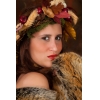|
 Playing with bright colors is probably one of
the most blatant temptations facing the designers in 2010 winter season. They offer
us so much more than a mere warm and cozy embrace of luxurious fur, but a
journey to exotic islands and warmer seasons with a wonderful and majestic
splash of daring colors. The trendsetters claim that any self-respecting
fashionista should challenge mediocrity and gloomy dreariness of colder season
with bright and alluring colored fur. Playing with bright colors is probably one of
the most blatant temptations facing the designers in 2010 winter season. They offer
us so much more than a mere warm and cozy embrace of luxurious fur, but a
journey to exotic islands and warmer seasons with a wonderful and majestic
splash of daring colors. The trendsetters claim that any self-respecting
fashionista should challenge mediocrity and gloomy dreariness of colder season
with bright and alluring colored fur.
Colored Fur: the History behind the Magic
Colored or dyed fur can hardly be called an
invention of the contemporary designers. In the history of fashion, it
has been
known for quite a long time. Colored fur first made its unforgettable
appearance in Europe in the late XIX century. Refreshingly original
samples
obtained with the use of aniline dyes, were brought to the Old World
from
America by the Frenchman Emile Chapal. Furriers quickly mastered the new
technique
and learned how to use it to imitate expensive furs.
The unprecedented surge on the colored fur market started
with the Futurism artistic movement: everything that bore the slightest
resemblance
of naturalness was immediately rejected and banished. In the 1960-s,
however, this
trend was revived by Paco Rabanne, who introduced fashionable fur coats
with
sparkling metal inlays.
A decade later, a daring and unpredictable
Yves Saint Laurent brought to the catwalk models in fox fur coats,
painted in
shrill tones of red and green. This design was dedicated to Brazilian
actress
Carmen Miranda. Fellow designers and later media criticized the
couturier for this
"outrage" and called his fashion experiments "disgusting". However, the
common people were delighted with Saint Laurent's bold palette and
welcomed his
experiments. That's how dyed fur has eventually reclaimed its spot in
the
limelight. In the future, the idea of colored fur was further developed
by Fendi
label.
Secrets of the Furrier Industry
Over the years, the secrets to making natural
fur bright and colorful have grown manifold. The simplest of them is
toning:
the whole fur surface, regardless of hair length, is dyed to one uniform
hue.
The unmatched effect is achieved for bright colors: aquamarine blue,
purple,
yellow, and orange. However, color preferences vary from designer to
designer.
More complex color schemes are also available
with the interplay of colors, or so-called colored streamers. Many
furrier masters
love the technique of dyeing in combination with bleaching. As a result,
each fur
hair has several color transitions. For instance, it can be brown near
the root,
red in the middle and gold at the tip.
Another popular technique is "cut and dry"
dyeing when "tiger" stripes, "leopard" spots and other prints
are applied to the surface of rabbit or goat skin. Leonard collection
featured a
fur coat with the print imitating the pattern on the birch tree, with
characteristic black blotches against a white background, while Etro
designers went
further and painted white fur with scarlet poppies.
The Times of Glamour Are Not Over Yet
Despite the visual appeal of dyed fur pieces,
they are yet to win the hearts of most people who prefer classical
natural fur,
such as mink, chinchilla and sables. And the reason is not that "dyed"
pieces are characterized by higher wear and tear. Rather, there are few
women
who can afford to buy a fur coat that will only stick for a season.
However, colored fur brings to mind the
vivacity of glamor. Who said that the reign of glamour in the fashion
end is
over? It continues its triumphal march, this time in a disguise of soft
and
fluffy colored fur, which can be seen in many designer collections,
including Betsey
Johnson, Bill Blass, Ann Demeulemeester and Blumarine.
|